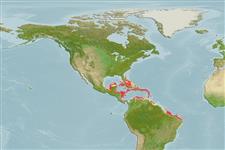Common names from other countries
>
Blenniiformes (Blennies) >
Chaenopsidae (Pike-, tube- and flagblennies)
Etymology: Lucayablennius: Composed from Lucaya = the old name for the Bahamas Islands + Greek, blennios = mucus (Ref. 45335).
Environment: milieu / climate zone / depth range / distribution range
Ekologi
marina revassocierade; djupintervall 13 - 106 m (Ref. 9710). Tropical
Western Central Atlantic: Bahamas and Caribbean, including the Antilles.
Size / Vikt / Age
Maturity: Lm ? range ? - ? cm
Max length : 5.0 cm SL hane/ej könsbestämd; (Ref. 51458)
Taggstrålar i ryggfenan (totalt) : 18 - 20; Mjukstrålar i ryggfenan (totalt) : 19 - 20; Taggstrålar i analfenan: 2; Mjukstrålar i analfenan: 22 - 23. With emarginate caudal fin. Reddish tan, with 3 large dark spots along rear of dorsal fin base, and 2 similar spots along rear of anal fin base (Ref. 26938). Black stripe from tip of lower jaw through eye to end of operculum; a median dorsal light yellow line on head (Ref. 13442).
Inhabits coral reefs (Ref. 5521). Drifts with bended tail to prey on small fish. Retreats into holes or empty worm tubes. Ignores divers (Ref. 9710). Often seen with schools of masked gobies (Ref. 26938).
Life cycle and mating behavior
Maturities | Reproduktion | Spawnings | Egg(s) | Fecundities | Larver
Böhlke, J.E. and C.C.G. Chaplin, 1993. Fishes of the Bahamas and adjacent tropical waters. 2nd edition. University of Texas Press, Austin. (Ref. 5521)
IUCN Red List Status (Ref. 130435)
CITES (Ref. 128078)
Not Evaluated
Threat to humans
Harmless
Human uses
Verktyg
Special reports
Download XML
Internet-källor
Estimates based on models
Preferred temperature (Ref.
115969): 23.5 - 27.6, mean 26.5 (based on 71 cells).
Phylogenetic diversity index (Ref.
82804): PD
50 = 1.0000 [Uniqueness, from 0.5 = low to 2.0 = high].
Bayesian length-weight: a=0.00457 (0.00183 - 0.01143), b=3.08 (2.86 - 3.30), in cm Total Length, based on LWR estimates for this (Sub)family-body shape (Ref.
93245).
Trofisk nivå (Ref.
69278): 3.5 ±0.5 se; based on size and trophs of closest relatives
Fishing Vulnerability (Ref.
59153): Low vulnerability (10 of 100).
